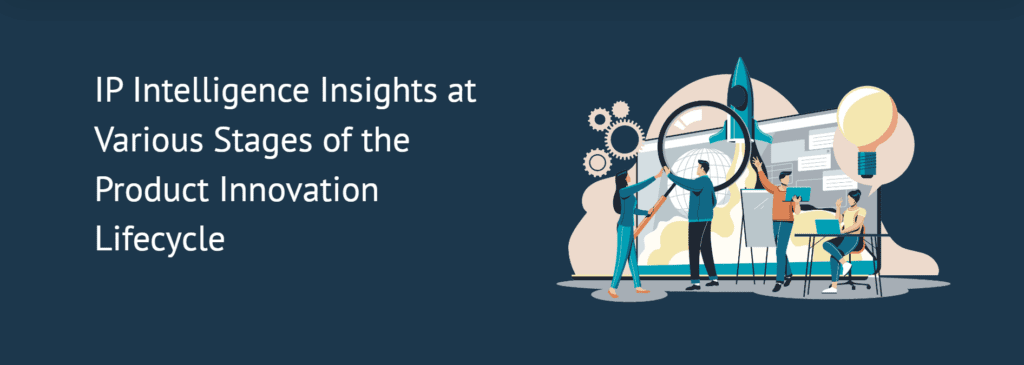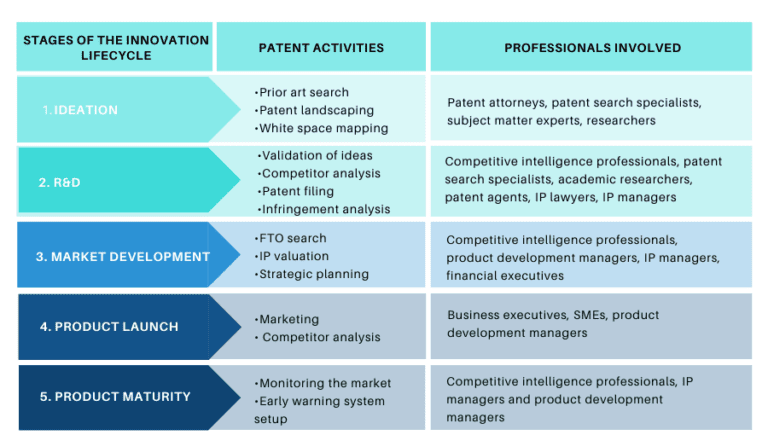Share
Share

IP Intelligence Insights at Various Stages of the Product Innovation Lifecycle
The innovation lifecycle captures different stages of the innovation process, favourable conditions, and the optimal time to use certain IP research and intelligence methods. Various teams including research, IP, legal and marketing as well as senior management are involved in particular stages. This article focuses on the process from a patent intelligence point of view and the professionals involved in each stage.
Take a close look at the figure below to understand the product innovation lifecycle step-by-step:

1. Ideation
This stage primarily involves generating new ideas which are then filtered based on a prior art search for patentability. Simply put, you need to ensure that the idea is novel, non-obvious and industrially applicable before proceeding to the next step, patent landscape analysis. For this evaluation, you must carry out a patent landscape analysis wherein you study the technology area such as its patent and assignee trends to gain insights on current technologies. Subsequently, you can conduct a white space analysis to validate promising technology areas with the help of patent attorneys, patent search specialists, subject-matter experts and researchers, to ensure you are not proceeding with the wrong idea.
2. R&D
During the R&D phase, you should align your ideas with company objectives by consulting competitive intelligence professionals, patent search specialists and academic researchers. Additionally, you must undertake a competitor analysis to pin-point the experts in the field so that you can benchmark your portfolio against your peers.
- Applied R&D
After the basic R&D stage, you should start the patent filing process to protect your idea by consulting patent agents and IP attorneys. It is crucial to have appropriate legal protection for your intellectual property so that your company can flourish in a volatile and competitive business climate. You also need to check if your patent might be infringing someone else’s by doing an infringement analysis. This will guarantee that the product doesn’t infringe anyone else’s patent after its launch.
3. Market Development
At this stage, a FTO (Freedom to operate) search is carried out to determine if testing or commercializing the product is possible without infringing existing intellectual property rights or not. Apart from that, you must perform an IP valuation in coordination with competitive intelligence professionals, product development managers, IP managers and financial executives. Their inputs will help you figure out the IP asset’s market potential, development costs, how to attract investors or partners and draft licensing agreements.
4. Product Launch
In this stage, you must search for a suitable acquisition target or partner to license, sell or transfer your product before you launch it in the market. Business executives and product development managers can work together to craft the best strategies for the product launch. In particular, you must focus on this product’s patent in your marketing strategy to demonstrate that it is superior, unique and safe. Study the competitors’ patent portfolios and their marketing initiatives so that you can gauge their current standing in the market and accordingly showcase the strengths of your product to customers.
5. Product Maturity
As the product becomes more established in the market, incremental enhancements and continuous innovation will help boost your product’s market value and maintain edge. You must seek advice from competitive intelligence professionals and monitor the market with an early warning system to capture threats from other companies before sales reduce drastically. IP managers, in particular, can maintain IP assets for the product; assist with managing new filings to capture all incremental innovations around the core patents, and take calculated decisions on the patent filings in other geographical regions that hold potential for the product.
Broadly speaking, these 5 stages cover the end-to-end cycle for innovation. Using IP intelligence properly helps you make the right decisions beginning from ideation to commercialization.




